

|
||
|
60
Leading Designers and Influencers of Sixties Fashions
|
|
John Bates - Pantsuits, catsuits, string dresses and see-through minis. John Bates was one of the 1960s most influential designers. Under the name 'Jean Varon' in 1959, he was creating futuristic fashion designs in plastic long before Andre Courrèges. and Pierre Cardin. A Jean Varon piece was chosen by the Fashion Museum in Bath as their highly prestigious 'Dress of the Year' in 1965. He is probably best-known for the designs he created for Diana Rigg (far right), who played Emma Peel in 'The Avengers' television series in 1965, and is considered by many to be one of the 'inventors' of the mini skirt fashion alongside Quant and Courrèges. Bridget Riley - (near right) Op-art artist and designer whose work was widely used in dress and fabric designs. Geoffrey
Beene - Born Samuel Albert Bozeman Jr, his first design job
was at Teal Traina, where he stayed until 1963, leaving to launch his
own label. Beene's 'signature' designs included elaborate seams, architectural
construction, graphic black and white motifs and clinging silhouettes
cut on the bias and were an immediate success. US Vogue featured Jean
Shrimpton wearing a dress from his first collection and within four
years he had an annual turnover of $4 million. |
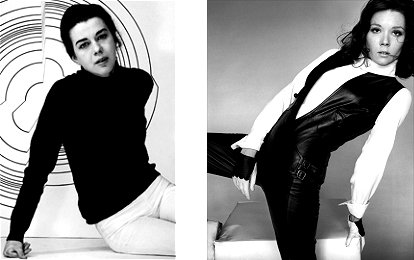
|
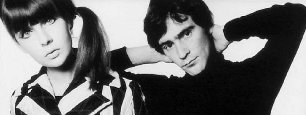 |
Bonnie Cashin
- U.S. designer specialising in Chinese styles, leather, canvas and suede
with ethnic influences, best known for popularising the 'poncho'. |
| Andre Courreges
- Miniskirts, pantsuits and see-through space-age designs. He opened his
own fashion house in 1961 after 12 years designing for Balenciaga. Like
Mary Quant, he has some claim to having pioneered the introduction of the
mini skirt in 1962. His most famous designs were the 'Space-Age' collection
of Spring 1964 which strongly featured silver and white PVCs with bonded
seams. The collection included silver PVC 'moongirl' pants, white catsuits and monochrome striped mini skirts and dresses. He is also famous for his use of the mid-calf length, flat-heeled 'Courreges' boot - an iconographic symbol of Sixties fashion. A more reasonably priced ready-to-wear collection was produced in 1965. Courreges also launched into the cosmetics market in 1970, subsequently introducing many classic perfumes including 'Empreinte', 'Eau de Courreges', 'Courreges pour homme' and 'Amerique'. Marc Bohan (Design director - Christian Dior) - Paris high fashion elegance. Marc took over the reigns at Dior in 1960 after the departure of Yves Saint Laurent. Elio
Fiorucci - Miniskirts
and general youth fashion. Italian shoe designer who exported many Sixties
London fashions to Italy, opening a store in Milan, 1967, specially for
London products. |
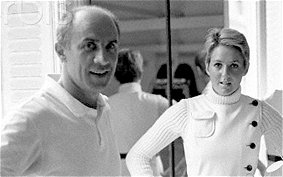 |
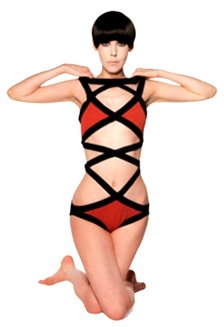 |
Rudi
Gernreich - Sports
and swimwear, revealing designs. Rudi designed ready-to-wear clothes for
Los Angeles boutique JAX until 1964 when he started his own company, striving
to provide a range of clothes which allowed complete freedom of movement.
He is credited with introducing the topless swimsuit (the 'monokini') in
1964, which consisted of a high waist held up by thin straps which passed
between the bare breasts. He gave up the company in about 1967 to concentrate on freelance designing and to devote more time to his passion - dance clothes. Hubert de Givenchy - Cocktail and evening dresses. Most famous for the clothes he designed for Audrey Hepburn, particularly her wardrobe in the 1961 film 'Breakfast At Tiffanys'. He is generally known for sack dresses, low-cut cocktail dresses with matching boleros, duster coats and coloured gloves. Arthur Sugarman - Founded Ben Sherman in 1963 in Brighton, recognising the potential for Oxford button down shirts, designing and creating styles like those he had seen during his time in the USA. Keith and Alan Freedman founded Brutus in London in 1966, making one style of jumper before extending the range to include shirts, jeans and t-shirts. The name came from the brothers’ favourite after shave – Brut 33. The Brutus brand was probably best known for their jeans and shirts particularly the Brutus Trimfit an update of the original Ivy League shirt with a sewn-in box pleat and figure-hugging style – the shirt of choice for mods, skinheads and suedeheads in the late 60s and early 70s. Janet Reger - London born designer who worked in Zurich until the late Sixties when she returned to London and marketed her products through Fenwick stores. Betsey
Johnson - Pantsuits, miniskirts and t-shirt dresses. |
 |
 |
Mary Quant - Miniskirts, tights, skinny-rib
sweaters and wet-look PVC. She produced designs for Butterick Patterns (paper
patterns) in 1964 to enable her styles to reach a larger market amongst
the less well-off. Mary is largely responsible for establishing London as the Sixties centre of fashion, particularly the King's Road area of Chelsea. Paco Rabanne - Plastic and metal discs, day-glo space-age designs. Between 1964 and 1966 Paco designed fashion accessories on a freelance basis for Balenciaga, Givenchy and Dior. He launched his body jewellery in the Spring of 1966 on forming his own company. Generally known for clothing in chain-mail style, made from plastic and metal tiles or discs, held together with wire. By 1968/9 his designs included ostrich feather dresses with aluminium bodices and others made in paper and silver leather. Zandra Rhodes - Fantasy evening fashions in vivid colours and bizarre patterns. Printed and painted silk and chiffon garments with art-deco motifs, zig-zags etc. Prior to forming her own fashion house in 1968, she had already designed a paper wedding dress which sold for less than two shillings (ten pence) during the brief period of popularity enjoyed by disposable clothing. Michelle Rosier - Space-age and wet look designs. Vivienne Westwood - Opened a shop in the Kings Road in the late 60s with Malcolm McLaren (of Sex Pistols fame). Better known for 70s 'Punk' and 80s 'New Romantic' fashions. |
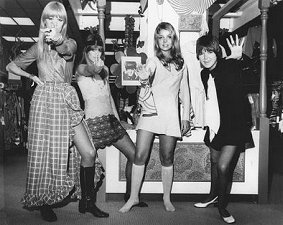 |
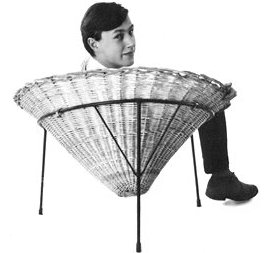 |
Oscar
de la Reuta - Designer for major fashion houses, working for
Balenciaga, Lanvin-Castillo, Elizabeth Arden and Jane Derby. Started his
own business in 1965 specialising in extravagant, opulent designs, mainly
elaborately-trimmed evening wear, particularly gypsy-style designs. John Stephen - Suede waistcoats, kaftan jackets, velvet flares, 'groovy' wigs. Terence Conran - The major force in raising design awareness during the Sixties. He opened his first 'Habitat' store at 77 Fulham Road in May 1964, concentrating on modern furniture and accessories. Douglas
Arnold 'Dougie' Millings - Bespoke men's fashion. Tailored
for many top 'pop' stars including The Beatles, Gerry & The Pacemakers,
Bill Haley, Cliff Richard, Giorgio Armani - Worked as a designer with Nino Cerruti from 1961 to 1974. |
  |
|
Barbara Hulanicki - Started her business by mail-order in 1963
with her husband, Stephen Fitz-Simon. Due to a phenomenal response to
their newspaper advertising, they opened their first 'Biba' boutique in
1964, selling mini smock-dresses, mix'n'match fashions, rubberised raincoats,
floppy hats and lengthened and dyed rugby shirts which were worn as mini-dresses,
many of which were decorated with op-art designs. Their favoured colours
were muted purples, dull reds, sepias, blues, greys and pinks. They moved
to larger premises in 1965 and again in 1969 when they opened a department
store in Kensington High Street, selling men's, women's and children's
wear (even purple nappies!). They also sold a variety of foods and household
goods but the expansion of the range seemed to be the start of Biba's
fall from youth popularity, eventually closing down in 1975.
also
see Bill Harry's Sixties - 'BIBA' Cristobal Balenciaga - Highly fashionable in the fifties, the house of Balenciaga carried on through the Sixties with famous name designers producing loosely tailored suits and sculptural evening wear. Balenciaga retired in 1968. Laura Ashley - Country style clothing and furnishing fabrics. Laura started with a cotton drill apron in 1961 - almost an anti-fashion house featuring inexpensive tucked and frilled dresses in coarse cotton and lacy shirts with leg o'mutton sleeves. She opened her first shop in Kensington in 1968. Anthony
Price - Glamorous evening wear and the designer of the clothes
for The Rolling Stones' 'Gimme Shelter' tour of 1967, while working as
a designer for Stirling Cooper producing fashions for Miss Selfridge.
He also later designed for Bryan Ferry and Roxy Music. |
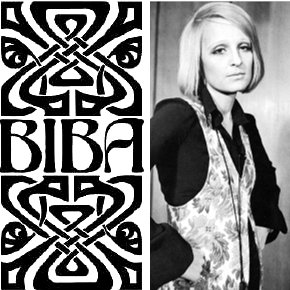 |
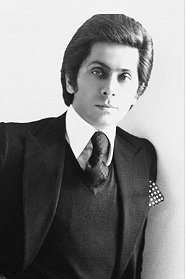  |
Charles Jourdan - Brightly-coloured suede and leather shoes. He also designed for leading fashion houses including Dior and Cardin. Calvin
Klein - Klein taught himself how to sew and sketch as a boy,
earning a place at New York's High School of Art and Design and the Fashion
Institute of Technology. He finally launched his own label in 1968, in
partnership with childhood friend Barry Schwartz. Noted for peajackets,
turtleneck sweaters and long-line slacks. |
 |
| Marion
Foale and Sally Tuffin
- Formed Tuffin & Foale in 1962, designing for the young, ready-to-wear
market which was bought extensively by London store Woollands. Best known
for lace dresses with cut-outs under the arms. Designer Marion Foale described
the general Carnaby area in 1962 as follows: "People lived there, there
was a dairy, a tobacconist, a newsagent - there was this little courtyard
and everything… a proper village, though very run down." Frederick Fox - Milliner who opened his own business in the mid-60s, designing hats for Hardy Amies, John Bates and the royal family. Andrew Grima - Jewellery designer who opened a business in Jermyn Street in 1966. Ralph Lauren - Ralph Lauren's empire was founded in 1967, after he opened his first ever tie shop, with no formal design training. Noted for 'Ivy League' styles and expensive neckwear, including 'kipper' ties. Simone Mirman - Milliner who designed for Dior, Saint-Laurent and Hartnell, including hats for the royals. Rose Vernier - Milliner who designed for Amies, Creed, Morton and Mattli. Tommy Hilfiger - Made his first moves into the fashion industry in 1969, while still in high school, with $150 and 20 pairs of bell-bottom jeans which he sold out of his Volkswagen to New York campus kids. Paul Reeves - Creator of unique designs for pop legends such as Jimmy Page and Jimi Hendrix. Founded the 'Sam Pig In Love' label with partner Pete Sutch and, in 1967 started making the kaftans with Nehru collars and half-belts at the back much loved by George Harrison and Mick Jagger that became a major fashion trend. Roger Vivier - Evening and haute couture shoes, also freelance footwear design for fashion houses. |
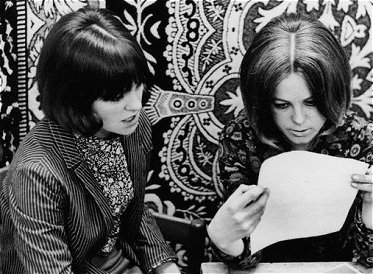 |
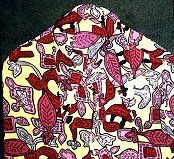 |
Bill Blass -
American sportswear and traditional designs with softened lines. Use of
ruffles in 60s designs. Donald Brooks - Luxurious evening pants and voluminous pyjamas, chemises, unadorned dresses, trimmed coats and stoles. Stephen Burrows - Leather fashion specialist. Jean Muir - Tailored and fluid matte jersey womenswear. Regarded by many as 'The Greatest British Fashion Designer', Jean started at Jaeger from 1956 to 1961 when she left to produce her own range of fashions under the 'Jane and Jane' label. This became part of the Susan Small organisation, later to be owned by Courtaulds. She opened her own company in 1966 producing comfortable and elegant women's wear including smocks, peasant dresses, shawls, draw-string waist dresses and two-piece suits. For more information, click here to see the great site dedicated to Jean and her work hosted by her nephew, Robin Norton. Caroline Charles - Worked with Mary Quant in the early days and started up her own business in 1963. Mini skirts in cotton and flannel, tunics, pants and, later, long flowing fashions. |
 |
| Clive
(Clive Evans) - Opened his own boutique in 1961, specialising
in haute couture and ready-to-wear daywear. Sybil Connolly - Hand woven woollens, tweeds and mohairs. Evening and daywear. Hilary Huckstepp - Winner of the RSA's footwear design award and the Bianca Mosca for fashion design. She designed footwear for Marks & Spencer and later fashion and maternity designs for her own label in 1964. See her son's dedicated website here.
|
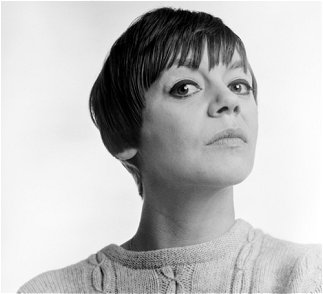 |
|
|
All
Original Material Copyright SixtiesCity
Other individual owner copyrights may apply to Photographic Images |